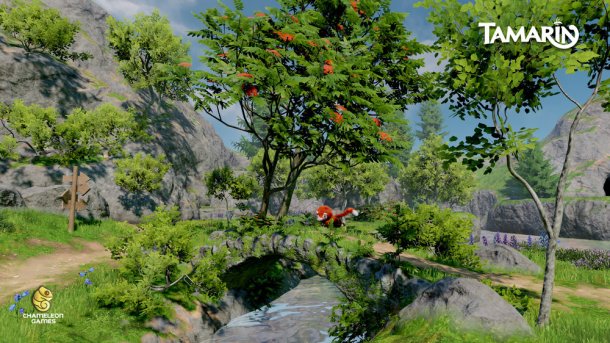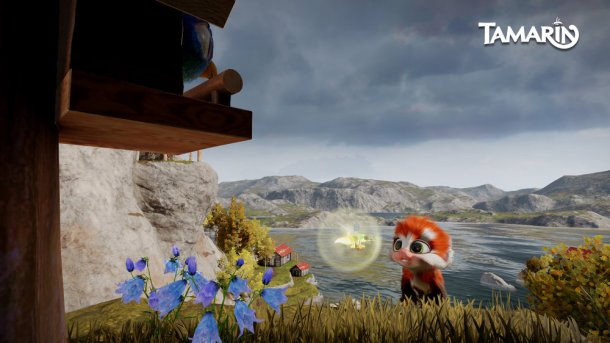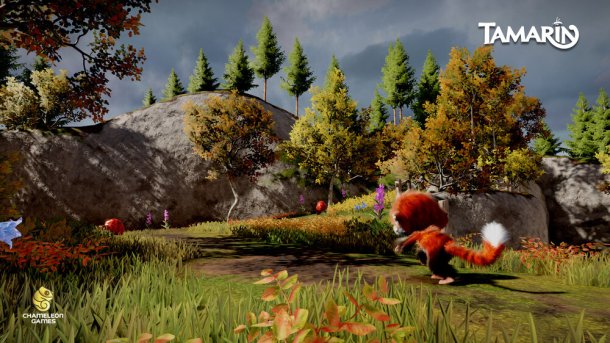When you think of video game protagonists, the tamarin does not immediately come to mind. A tamarin is a New World monkey from Central and South America that Omar Sawi and his development studio, Chameleon Games, has placed as the central character in the upcoming Rare-inspired title Tamarin. In Part Two of our two-part interview, Omar Sawi and I discuss the how he joined both the 3-D platforming and action shooter parts of the game into one cohesive whole, how Rare influenced Tamarin, how David Wise developed the game’s soundtrack, and more.
You can check out Part One of the interview here.
You can check out (and pre-order) Tamarin at the Chameleon Games official website, like them on Facebook, tweet them on Twitter, subscribe to them on YouTube, and follow them on Instagram.
Tamarin is available now for discounted pre-order on the official website here in a digital regular to digital deluxe edition.
Tamarin is scheduled to be released later this year for PlayStation 4 and PC.
This interview has been edited for content and clarity.
Operation Rainfall: Was it hard finding that balance between the disjointed elements to make it not come across as [though] two styles were Frankenstein’d together?
Omar Sawi: You’d probably have that argument with any kind of entertainment where the vision is “What is better: is it better to have an album where all the songs are dance hits or all the songs are classical?” and you stick to that style and you keep it that way the whole way through. Or do you want to appeal by putting a balance between the pop songs and the dance hits? So you have a little bit of a variety in your album. And maybe alienating some of those who only want this part or that part.
So my vision for this game was that contrast, the variety and surprise that would be an element of at least this situation of Tamarin, to see how we could create a new structure of gameplay that would change- we tried a lot of things on how to balance the gameplay with work and not just to copy another game and make a sequel of that one game, but to mix things from different genres and [for the game to] not be defined into a box.
So you will play the game, and you will find something new happening, something exciting that you didn’t expect- like going to the underground and suddenly you’re inside something like a dance club, and there’s dancing and they have their own culture. And so you feel rhythm and energy and excitement and movement. So, I think that’s nice to have a little bit of a surprise in a game. Hopefully it comes across as not throwing things together, and it’s one concept in total.
OR: You didn’t work for Rare, right?
OS: I did not work for Rare, no.
“And it was decided from the beginning that we would have, basically, two kinds of music: one was the atmospheric part, which would be more in the direction of the Donkey Kong Country soundtracks, and the other part would be to try something new that he hadn’t tried before.”
OR: Even though you didn’t work for Rare, you surround yourself and Tamarin with Rare veterans. What was it about those SNES and Nintendo 64 Rare titles that made you want to seek out these people to work with?
OS: I had, at some point, an idea of working at Rare, because they made the best games in the world at one point, from my perspective. Together with Nintendo, I thought their games were just some of the best, and they were European. So I went to England from Norway, and started to [get] my education there. But over time, the variety disappeared in the types of games they were making. And I tried to find out why, what happened, why there were so few games coming. You had shooters, platformers, you had things in-between that would mix things up. So there was a great variety there, and I enjoyed that variety- you want to see a variety in games. You don’t want to just have one kind of thing. And I thought that they were just so high quality.
And so the research there led me to find out who worked on those games, understanding what happened, getting in touch with them, and bringing them together. So [Tamarin] became a vision also for bringing together those people who had the vision of these things that they made in the past.
OR: What is your favorite Rare game, and why?
OS: My favorite Rare game. That one is a really hard one to answer, because I like a variety of them. It’s the variety that makes what [Rare] did in that era interesting- its how they had a lot of different games that were really good. But I have a few favorites. And the favorites would be Donkey Kong County, Banjo-Kazooie, and Jet Force Gemini.
And why? Because I like the atmosphere on Donkey Kong County. I think it was colorful, it had animals in it, and it went into nature. It just had a very great atmosphere- it wasn’t just fun, it had a certain melancholy appeal. [That] came a lot from David Wise’s music, and why I wanted to work with him.
Banjo-Kazooie was pure fun. The gameplay and the way the 3-D adventure worked was just a lot of fun, and that was something I think a lot of the exploration it brought in the 3-D elements, where you can explore worlds and find things and find secrets. And by using the third dimension, it becomes more interesting- that was something that was missing in a lot of 3-D platformers, because it’s really exciting when you have these worlds that you can explore in 3-D and are not too big, but at the same time, big enough that you really feel you can get to know the place you’re in. And get to know the environment and become familiar with it. It’s not linear, but you can really explore.
And Jet Force Gemini was also an inspiration. It was a surprise in how it was a fun game to play.

OR: Moving back to Tamarin– you mentioned earlier that David Wise is creating the game’s soundtrack. Is he creating the music in a vacuum, was he given portions of the game to develop the soundtrack from, or what is his development process like from your perspective?
OS: He definitely didn’t work in a vacuum, because he always wants to have something from the game to which he is supposed to make that music so it would fit. In the beginning, what we had was not as polished as what we have now, but it started with the visuals that the reference images that we were working towards, and then later on the 3-D graphics that we had. And then later on as well, more of the final gameplay that it developed into. And it kept going over several years, because he was on it from the beginning.
And it was decided from the beginning that we would have, basically, two kinds of music: one was the atmospheric part, which would be more in the direction of the Donkey Kong Country soundtracks, and the other part would be to try something new that he hadn’t tried before. And that was the dancing part, and the rhythmic part and to make something catchy- almost like a pop song or rhythm. Because we wanted the idea that the ants would dance, and that they would do their movements in sync to the music. That was something new that we wanted to try. And that was a challenge, because we didn’t have a set way of doing that, and it took time before the rhythmic aspect was fully developed so the movement animations could actually sync to the music. And we started with a beat, and decided the pacing of that beat- how quickly it should go. And he developed a rhythmic track around that.
And then later on when the game got more and more finished, he filled in with the audio [tracks] that were missing. Basically, he would look at gameplay footage and try to match in audio for what he could have a good idea [for] pacing that would fit in that particular area. And so he got a lot of details about each area consists of [as] I was sending him a lot of materials.
OR: What platforms is Tamarin coming out for?
OS: We’re focusing on PlayStation 4 and PC this year.
OR: Do you have a release date in mind?
OS: It’s coming out in Q4 2019.

OR: Final question- to somebody who may have never heard of Tamarin before this interview or the latest press release, and is interested in maybe picking it up- what do you have to say to them?
OS: If you’re interested in nature or trying a game that is different- if you like fun games, 3-D platformers, cute games like [from] the Nintendo 64-era, and want to see more colorful games, more games that are about adventuring and exploration, I think Tamarin is something that tries to stay true to that vision.
It has smooth gameplay and great movement and energy and [it] is about nature. And [it has] nice locations to go to, because that is really what the game’s about- having great experiences and being taken to another place that’s interesting to go to. That’s what we really tried to do with Tamarin, to take you to somewhere interesting and [you] have fun being a tamarin.
OR: Thank you.
What do you think of Tamarin being influenced by Rare’s prior games? Are you planning on picking Tamarin up at launch?
Let us know in the comments below!







